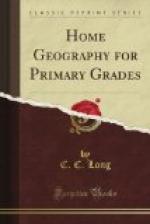Name two animals covered with fur.
Two covered with hair. Two covered with feathers.
What do we call the covering of a sheep? Of a pig? Of what use is hair to animals?
What covering has an oyster? A lobster? A turtle? Of what use is it to them?
The duck’s feathers are covered with an oily coating, which keeps them from getting wet. Are the feathers of the hen so covered? Why?
Suppose a squirrel’s covering were like that of a turtle’s, what would result?
What would result if a bird had scales instead of feathers? You see that each animal has that covering which suits its habits best.
LESSON XXXIX.
USES OF ANIMALS.
What domestic animals are used for food?
What wild animals are used for food?
[Illustration: “WHAT DOMESTIC ANIMALS ARE USED FOR FOOD?”]
From what animals do we get beef? pork? mutton? veal?
What birds and fowls are used for food? What fishes?
From what animal do we get wool? How is wool taken from the sheep? What articles of dress are made of wool?
[Illustration: “FROM WHAT ANIMAL DO WE GET WOOL?”]
Name the animals whose skins are used to make leather. How is leather prepared? Did you ever see a tannery? What do they do there?
From what animals do we get furs?
What is silk?
[Illustration: THE SILKWORM AND MOTH.]
Silk is made by little worms called silkworms. When the worm is fully grown, it spins round itself a small ball of silk, called a cocoon. If this cocoon were left to itself, the worm would change to a moth, and the moth would eat its way out of this little house. But this, of course, would cut the little threads and spoil the silk. As soon, therefore, as the cocoon is made, it is put into hot water to kill the worm. In this way the silk is saved.
Almost every part of the cow is made use of. For what is the flesh used? What use is made of the hoofs? horns? hair? What is done with the skin? What other uses has the cow?
What animal shows the most affection for his master?
Mention some kinds of dogs.
You may have seen a dog called the St. Bernard. He is large, with long curly hair. In the Alps mountains, where traveling is dangerous, the St. Bernard dogs have saved many lives. Who use their dogs, as we use horses, to draw their sledges?
Which is the most useful animal to man?
Draw and paint some of the animals spoken of in the lesson.
Write the names:
Of animals useful for food.
Of animals which work for man.
Of animals useful to us for clothing.
Of birds and fowls used for food.
LESSON XL.
THE SIGNS OF THE SEASONS.




